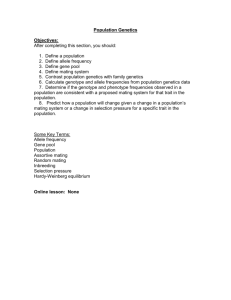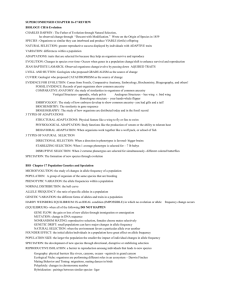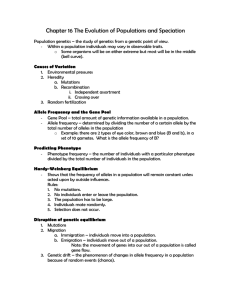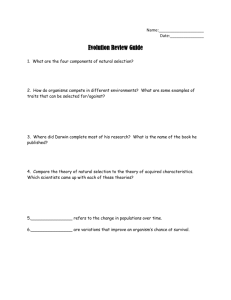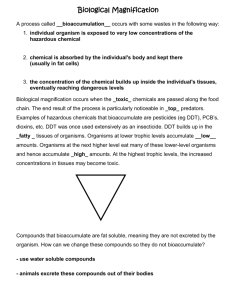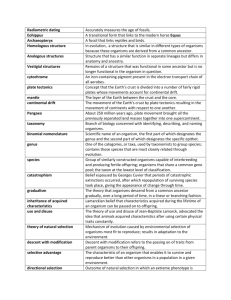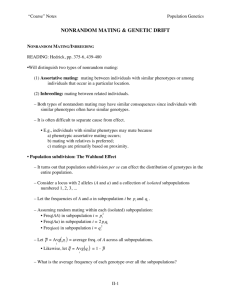Exam 1
advertisement
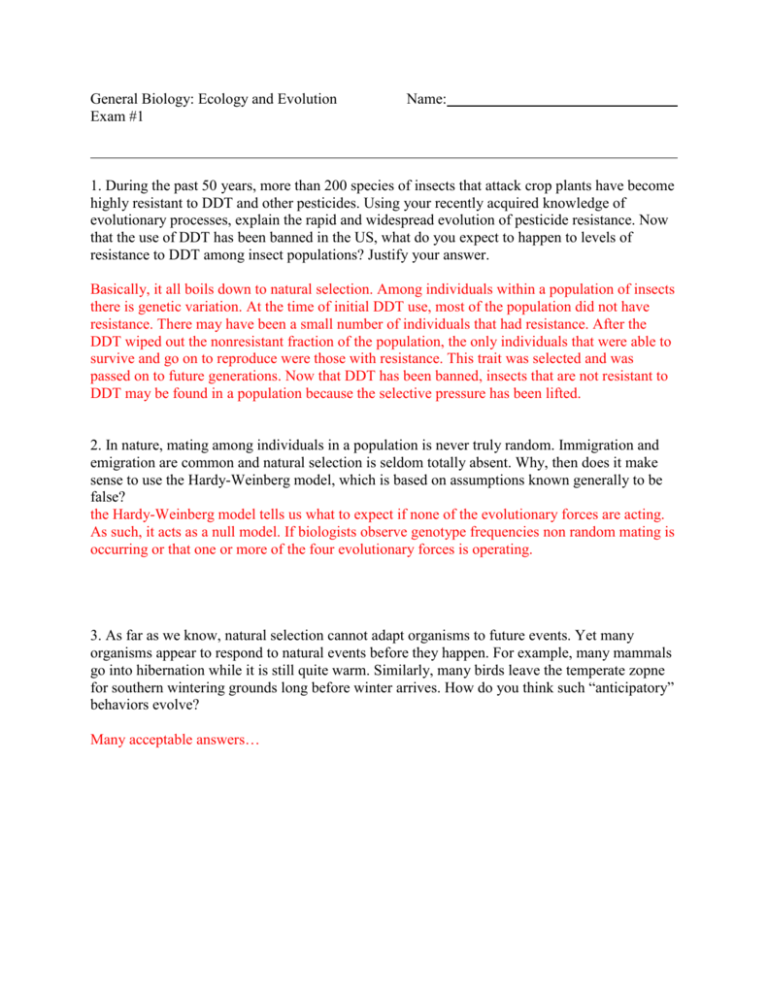
General Biology: Ecology and Evolution Exam #1 Name: 1. During the past 50 years, more than 200 species of insects that attack crop plants have become highly resistant to DDT and other pesticides. Using your recently acquired knowledge of evolutionary processes, explain the rapid and widespread evolution of pesticide resistance. Now that the use of DDT has been banned in the US, what do you expect to happen to levels of resistance to DDT among insect populations? Justify your answer. Basically, it all boils down to natural selection. Among individuals within a population of insects there is genetic variation. At the time of initial DDT use, most of the population did not have resistance. There may have been a small number of individuals that had resistance. After the DDT wiped out the nonresistant fraction of the population, the only individuals that were able to survive and go on to reproduce were those with resistance. This trait was selected and was passed on to future generations. Now that DDT has been banned, insects that are not resistant to DDT may be found in a population because the selective pressure has been lifted. 2. In nature, mating among individuals in a population is never truly random. Immigration and emigration are common and natural selection is seldom totally absent. Why, then does it make sense to use the Hardy-Weinberg model, which is based on assumptions known generally to be false? the Hardy-Weinberg model tells us what to expect if none of the evolutionary forces are acting. As such, it acts as a null model. If biologists observe genotype frequencies non random mating is occurring or that one or more of the four evolutionary forces is operating. 3. As far as we know, natural selection cannot adapt organisms to future events. Yet many organisms appear to respond to natural events before they happen. For example, many mammals go into hibernation while it is still quite warm. Similarly, many birds leave the temperate zopne for southern wintering grounds long before winter arrives. How do you think such “anticipatory” behaviors evolve? Many acceptable answers… 4. Some people believe that species, like individual organisms, have life cycles. They believe that species are born by a process of speciation, grow and expand, and inevitably die out as a result of “species old age.” Could any of the agents of evolution cause such a species life cycle? If not, how do you explain the high rates of extinction of species in nature? Many acceptable answers… 5. Sexual selection, like inbreeding, is a form of nonrandom mating. How do these processes differ? Why does sexual selection frequently lead to sexual dimorphism, with males showing exaggerated characteristics? Nonrandom mating means any force that causes mating to be nonrandom. This includes inbreeding. Sexual selection refers to the specific situation in which individuals in a population differ in their ability to attract mates. Inbreeding affects all loci. Sexual selection affects loci that code for mate choice traits. Sexual selection often leads to sexual dimorphism, with males showing exaggerated characters because sexual selection is most intense on the sex that makes the least investment in the offspring. Females invest more in offspring, and their lifetime reproductive success is limited more by access to resources needed for bearing and rearing young. For a male, reproductive source is limited by the ability to gain access to a mate. 6. Cystic fibrosis is a genetic disease of humans caused by homozygosity for a recessive allele (aa). In a particular large population, the frequency of newborns affected with cystic fibrosis is 1 in 3,600. In this population, what proportion of couples/marriages between normal, genetically nonrelated individuals is at risk of producing a child with cystic fibrosis? (hint – this is a HardyWeinberg problem!) p1= frequency of the dominant allele (A) p2= frequency of the recessive allele (a) If the frequency of newborns affected with CF is 1 in 3600 the genotype of these individuals is aa. Therefore the p22= 1/3600 The expected genotypes ratios are: p12 : 2 (p1p2) : p22. = 1/60. To find out the frequency of the recessive allele in the gene pool, take the square root of 1/3600 = 1/60 Because p1 + p2 = 1.0 the frequency of the dominant allele (A) must be 59/60. 2 (p1p2) = approximately 2 (because p1 is very nearly 1) so 2/60 = 1/30 the expected frequency of Aa genotypes in the population. So 1/30 x 1/30 = one family in 900 7. In what sense are humans acting as agents of selection of other species? Name an organism that you think is favored by the environmental changes humans cause. Many acceptable answers… 8. Consider the following two quotations from your textbook (chapter 1): If the theory of evolution is true, the SSU RNA sequences should be very similar in closely related organisms, but less similar in organisms that are less closely related. On a phylogenetic tree, branches that are close to one another represent species that are closely related; branches that are farther away represent species that are more distantly related. These statements explain the logic behind using molecular sequence data to estimate evolutionary relationships. Is this logic sound? Why or why not? Yes, the logic behind using molecular data is sound because organisms that diverged a long time ago have had more time to accumulate mutations, and should thus show greater sequence differences in their DNA. 9. The average height of humans has increased steadily for the past 100 years in the industrialized nations. This trait has clearly changed over time. Most physicians and human geneticists believe that this change is due to better nutrition and less disease. Do you think that human height has evolved? Support your answer using as criteria the forces driving evolution. Height increase in humans over the past 100 years is more likely due to environmental changes in health care enabling each individual to more fully realize their height potential. There is no documented evidence that changes in the allele frequencies of genes that control height have occurred in the human population over the last 100 years, so there is no evidence of evolution. Height is a quantitative trait that is known to be affected by environmental conditions and probably by multiple genes. As a quantitative trait, an individual inherits a range of possible heights, and then environmental conditions act to determine how much of that range is realized.
